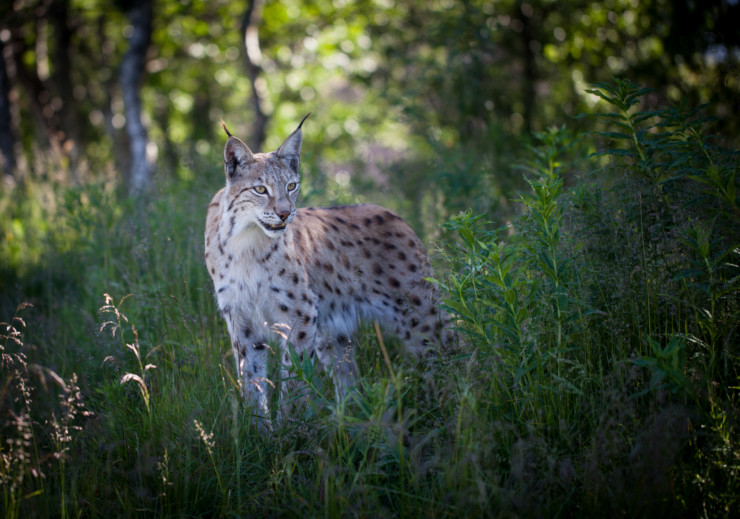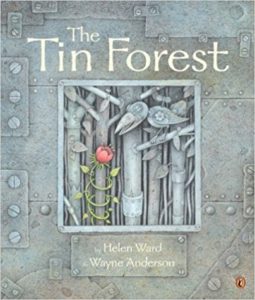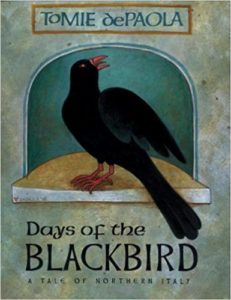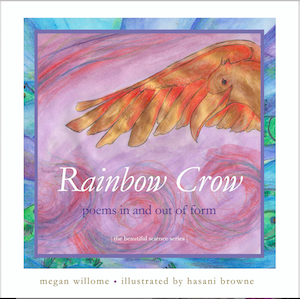For the selections thus far in our children’s book club, if I didn’t already own the book, then neither did my library, and I had to request it through Interlibrary Loan. But the library did have The Tin Forest. I suspect it had something to do with the sticker on the cover identifying it as a Reading Rainbow book.
(Can you hear the theme song in your head? (If not, listen now! Don’t you feel happier?)
Hosted by actor LeVar Burton, Reading Rainbow ran on PBS from 1983-2006. The episode on which The Tin Forest was read ran in 2002. The subject is the aftermath of 9/11, specifically, what happened to the students who attended PS 234 in Manhattan. The theme of the episode, like the theme of the book, is hope.
Because I’d never heard of this book, I now have its story and the story of this particular elementary school intertwined. That’s not necessarily a bad thing. This book was suggested by a friend, and I don’t think I would have picked it up on my own.
What I liked about this book — instantly — was the artwork by Wayne Anderson. I adore the gray-blue tin forest he creates. I can’t get enough of the toucans, the lizards, the flowers, the tree frogs, the leaves. The note on the book jacket says, of Anderson, “His art studio is packed from floor to ceiling with broken clocks, cracked microscopes, and other odd bits and pieces. This jumble of seemingly useless things served as inspiration for the illustrations in The Tin Forest.”
I also love the story’s real forest, illustrated first in a book the old man reads, then in his dream, then in isolated patches, then in full color. The primary color is yellow, and it stands in stark contrast to the metallic gray of the tin forest. For me, the art of this book works better than the text. I think I would prefer it as a wordless picture book.
That being said, I am completely drawn to this old man, who lived in “a wide, windswept place, near nowhere and close to forgotten,” who every day “tried to clear away the garbage,” and who dreamed tropical dreams. I fancy a fella who sees a broken light bulb and suddenly “an idea planted itself in his mind” — that with a little tinkering that light bulb could look like a flower. And I love that such a small idea “grew roots and sprouted. Feeding on the garbage, it grew leaves. It grew branches. It grew bigger and bigger” until, under his hand, “a forest emerged. A forest made of garbage. A forest made of tin.”
“It was not the forest of his dreams, but it was a forest just the same.”
In this story, a dream forest is not enough. A small bird finds the man’s house, and the man shares crumbs from his sandwich. The bird returns with its mate and, more importantly, with seeds: “They dropped them to the dry ground. Green shoots broke through the earth.” Those shoots lead to more birds, to insects and leaves, to small creatures, and finally, to wild animals. From garbage to glory.
Which brings me back to the story of PS 234. Following 9/11, the kids are relocated to a new school for several months, one that hasn’t held classes in years, so they have to sit on the floor and make due. It’s basically a tin school compared to their real one. Once back at their old school, the kids make a video to say thank you to everyone who helped them or sent gifts. They make a sign, basically a giant thank you note, and sing a song.
Burton: “Did you ever think you’d hear yourself say that, that you really missed your school?”
Girl: “No.”
(I wish I could convey to you the amount of attitude packed into that one-word answer.)
Burton tells the audience that one way the kids recovered hope after 9/11 was learning they weren’t alone. And that’s what bugs me about The Tin Forest. Over the course of the story the old man changes the forest from something “filled with all the things that no one wanted,” to something “filled with all the things that everyone wanted.” But we never see “everyone.” He’s still alone.
Unless you count the animals. The man’s connection with nature in the midst of his desolation and how nature grows from dreamt to constructed to lived is, I think, why the book endures. After all, I have often, on a hopeless day, taken a walk down a country lane and instantly felt a bit more hopeful.
The book jacket says this about the inspiration of its writer, Helen Ward: “Inspired to tell a tale of the force of nature, she shows how even the most barren landscape can become a home for all sorts of life.” The winner of several awards in the UK, Ward was an illustrator before she was an author. She’s shy about her awards, preferring this evaluation from a PE teacher long ago: “Helen tries hard.”
The Tin Forest was published in 2001, making it a natural choice for a Reading Rainbow episode about 9/11. The larger theme of the episode was picture books for dark days: “If you’re ever going through a rough time, the students at PS 234 would like to help you out by suggesting some books that will make you feel better,” Burton says, then adds, as he does in every episode, “But you don’t have to take my word for it.”
Or mine. Read The Tin Forest for yourself and let me know what you think about the interplay between text and illustrations.
_______________
The next Children’s Book Club will meet Friday, January 12: We will read Days of the Blackbird, written and illustrated by Tomie dePaola.
Photo by Tom Bech, Creative Commons via Flickr. Post by Megan Willome, author of The Joy of Poetry.
Browse Children’s Book Club
“Megan Willome has captured the essence of crow in this delightful children’s collection. Not only do the poems introduce the reader to the unusual habits and nature of this bird, but also different forms of poetry as well.”
—Michelle Ortega, poet and children’s speech pathologist
- Perspective: The Two, The Only: Calvin and Hobbes - December 16, 2022
- Children’s Book Club: A Very Haunted Christmas - December 9, 2022
- By Heart: ‘The night is darkening round me’ by Emily Brontë - December 2, 2022




L.L. Barkat says
I love your perspectives, Megan. So keen.
And now I am mulling what to do in a new children’s book I’m working on with a beautiful, beautiful artist. What a dance, to find the just-right combination of pictures and words!
(Fascinating history you brought forward, too, and I was so touched by the freight of “No.”)
Megan Willome says
A small word, in wise hands, can do so much.
I can’t imagine having to navigate the interplay between pictures and words while a book is coming together. Often an illustrator is chosen after its text has already been accepted by a publisher, so the author has no idea how the story is being portrayed. But I know it’s different in your world.
L.L. Barkat says
I’m not sure I could do it any other way. It’s an unfolding and a creative partnership. 🙂
Sandra Heska King says
Hmmmm… do I know this illustrator. I wonder?
Sharon A Gibbs says
Eager to see this creative work. 🙂
L.L. Barkat says
This is a beginning. Just the beginning of a beginning. Which means it will shift. But inspiration needs to start somewhere…
https://www.instagram.com/p/BcfTcNvDh7e/?taken-by=tspoetry
Megan Willome says
I’m already inspired!
Katie says
Megan,
I did feel happier after listening to the Reading Rainbow theme song:) Thanks for the link!
And after, reading that show ending quote of Lavar Burton’s: “But you don’t have to take my word for it.”
Thank you for this review and gently sharing your thoughts about The Tin Forest. I especially appreciated these quotes/comments:
“It was not the forest of his dreams, but it was a forest just the same.”
From garbage to glory.
My children and I really enjoyed and learned a lot from RR and I always seemed to feel not just a bit happier for watching, but more hopeful as well.
Megan Willome says
So glad to hear from another “Reading Rainbow” fan!
Sandra Heska King says
So I “cheated” and found this story online.
I kind of liked the animation.
One of my takeaways was that sometimes it takes time for hope to grow, so we should never stop dreaming. Maybe he’s alone at the end of the book, but maybe he’s not done dreaming for more. And maybe… just maybe it’s not the end of the story. Maybe one will come–or everyone. And then, I wonder, what would happen to his original dream. Like our neighborhood… created by gutting a portion of the Everglades…
I like how this book brought hope after 911. And I always loved Reading Rainbow.
Megan Willome says
Sandy, I watched that video several times! I like how it shows that there is more than one way to illustrate a text. This one definitely evokes the original, but it does a better job with the tin colors than with the forest ones.
And I like your idea that maybe the story isn’t done. Maybe he’ll keep dreaming and new hope will emerge.
Sandra Heska King says
Well, now for sure, I’m going to have to track down the book to compare.
Sharon A Gibbs says
Very well done!
I do prefer the book’s colors to the video’s but loved the video’s sound effects: clangs, creaks, and clatter. 🙂
Thanks for sharing, Sandy.
Donna says
I’ve never seen this book! Thanks so much for sharing it with us, Megan. This line really stood out to me: “Feeding on the garbage, it grew leaves.” I need to get the book now, too- the video is lovely.
Megan Willome says
Knowing your thing for color, Donna, I’d be anxious to hear your thoughts as an artist.
Bethany R. says
Thanks for this interesting post, Megan. I’m going to request the book from my library so I can read it with my daughter and see what she thinks of it.
Interesting observation about him still being the only person at the end. I like your idea, Sandy, about what might happen in later unseen pages.
Megan Willome says
Let us know what she thinks, Bethany. Children are honest critics.
Sharon A Gibbs says
Ahh, such a treat to start my Saturday with coffee and The TSP Children’s Book Club! What could be better? And the “Reading Rainbow” song, well, it made me glad.
I pulled out my library copy and reread it. How sad I was to see that this book’s last Date Due stamp was from February 28, 2014.
Megan, I love how you delved into this and paired it with PSA 234’s story. We can learn so much from children. 🙂 Of course, I had to find that “Reading Rainbow” episode and watch it in its entirety. Hope is definitely a major theme.
This children’s fantasy also encourages the reader to act on their dreams (and I love the illustration of him dreaming at night—like his dreams are sweeping him away to a beautiful, faraway land). The man’s hope feeds his sense of determination and imagination as he creates transformation, despite that feeling of “near nowhere and close to forgotten.” (Haven’t we all felt that a time or two in life?
I get your concern about the man being alone at the end, but I am wondering if the author is trying to tell us that there is beauty even when things aren’t exactly the way we want them to be. Just a thought.
As for the interplay of the text and illustrations, the gray font’s cold pipe-like appearance adds to the metallic qualities of the illustrations.
And now to add the PSA 234 students’ recommendations to my reading list:
“Mole Music” by David McPhail,
“On That Day” by Andrea Patel, and
“The Wonderful Happens” by Cynthia Rylant, illus. by Coco Dowley
Megan Willome says
Sharon, I like this: “there is beauty even when things aren’t exactly the way we want them to be.” That puts a really interesting twist on the story.
Sharon A Gibbs says
The Reading Rainbow The TIn Forest episode…
Megan Willome says
Thank you!
Katie says
Sharon,
What a treasure to have seen this RR program – thank you SO much for the link!
We do indeed learn much from children:) Want to share a cinquain and haiku prompted by watching the video:
Thank you
Two thirty-four
for sharing your thank yous
you give us hope, you bring us cheer
well done!
the towers fell down
right on down smack on the ground
we rose right back up
Gratefully,
Katie
Megan Willome says
Katie, I’m so grateful for your poems & grateful that “Reading Rainbow” inspired them.
Katie says
Thank you, Megan:)